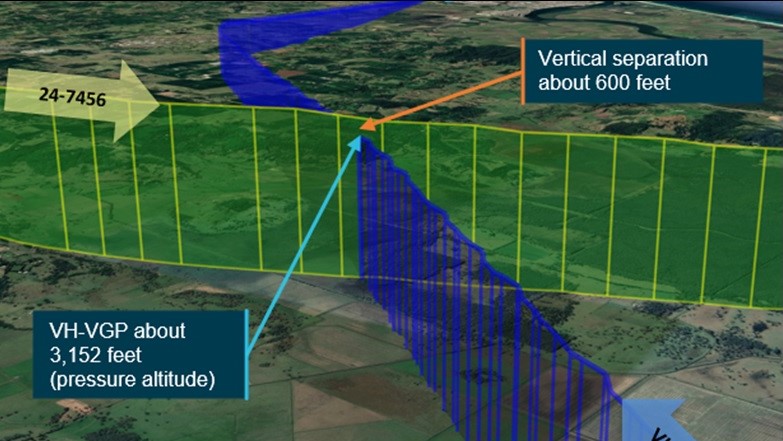
|
Key points:
|
The pilot of a Jabiru recreational aircraft was unaware of the presence of an Airbus A320 before the flight paths of both aircraft inadvertently intersected while flying in non-controlled airspace near Ballina Airport, an Australian Transport Safety Bureau investigation details.
The Jetstar Airways A320, with 2 flight crew, 5 cabin crew and 163 passengers on board, was conducting an approach to land at Ballina while the Jabiru, with a pilot and passenger on board, was tracking to the south-west of Ballina en route to Evans Head when their vertical separation reduced to approximately 600 ft (183 m) as their flight paths intersected, with no observed lateral separation. Both aircraft landed at their destinations without further incident.
The ATSB’s investigation into the 28 November 2020 incident details that the A320 flight crew were unaware of the impending conflict until alerted to the presence of the Jabiru by their aircraft’s traffic collision avoidance system (TCAS).
However, the Jabiru pilot had not set their aircraft's transponder to broadcast altitude data (mode 3C), so the A320’s TCAS was unable to provide its flight crew the necessary information to positively avoid the potential collision.
“The pilot of the Jabiru had not selected their transponder to broadcast altitude information, and did not recall hearing radio broadcasts from the A320 until passing above it,” said ATSB Chief Commissioner Angus Mitchell.
“The A320 flight crew, meanwhile, did not recall hearing the Jabiru’s most recent radio broadcast when it was near Lismore; remained unaware of the Jabiru until receiving the TCAS alert; in the brief time available to them did not attempt to make radio contact with the Jabiru; and only sighted it moments before their flight paths converged.
“Consequently, as the pilots of neither aircraft had been able to manage separation from the other aircraft, the vertical separation between them was influenced by chance alone.”
Airspace surrounding Ballina is non-controlled, that is, aircraft are required to maintain separation through see-and-avoid principles – visually sighting other traffic and monitoring radio transmissions – rather than having separation services provided by air traffic control.
“The airspace surrounding Ballina Airport accommodates a complex mix of aircraft types and operations, and there is a number of other non-controlled airports in close proximity,” said Mr Mitchell.
“The ATSB determined that while the available evidence did not support a conclusion that the present system of aircraft self-separation in Ballina airspace is unsafe, there is the opportunity to potentially further reduce safety risk.”
Measures to further reduce risk might include the increased use of controlled airspace, the increased use of ADS-B aircraft surveillance data, both by air traffic services and in-aircraft, and the identification of any increasing risk through the improved monitoring of the quantity and complexity of aircraft movements in Ballina airspace.
“The ATSB supports systemic enhancements to the overall air traffic system that provide a net overall benefit to safety,” Mr Mitchell said.
The investigation notes that a Civil Aviation Safety Authority 2015 review of the airspace surrounding Ballina determined that a higher airspace classification, such as introducing controlled airspace in the vicinity of and an air traffic control service at Ballina was not appropriate.
However, the ATSB found that that review and periodic risk assessments of the airspace did not consider the risks associated with aircraft transiting through the airspace without taking off or landing at Ballina, as occurred in the investigation occurrence.
CASA has advised the ATSB that its most recent review of Ballina airspace is expected to take into account data for transiting aircraft that had either filed a flight plan or been detected by secondary surveillance radar. In addition, CASA has advised it has also developed an airspace risk modelling system that will have an enhanced capability to consider transiting aircraft.
Separately, the investigation notes that at the time of the occurrence pilots of aircraft operating within 10 nm of Ballina were required to make positional calls on the common traffic advisory frequency (CTAF). In this occurrence, the two aircraft’s flight paths intersected approximately 12 nm to the south-west of Ballina. However, in January 2021 CASA expanded the Ballina CTAF broadcast area to 15 nm.
In addition, in August 2021 Airservices Australia introduced a surveillance flight information service (SFIS), where an air traffic controller based in the Brisbane Air Traffic Services Centre provides traffic information (but not traffic separation) to aircraft operating within the Ballina 15 nm CTAF broadcast area.
The SFIS replaced a certified air/ground radio service (CA/GRS), which was in operation at the time or the occurrence. The CA/GRS was located at Ballina Airport and provided traffic information (but not traffic separation) to aircraft within the then 10 nm CTAF broadcast area.
Read the final report: Separation occurrence involving Airbus A320-232, VH-VGP and Jabiru J230D, 24-7456 near Ballina Byron Gateway Airport, New South Wales, 28 November 2020


